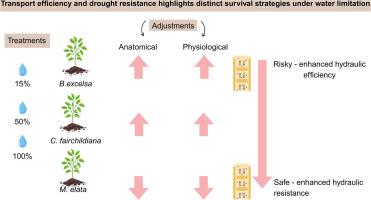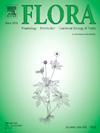Anatomical and physiological adjustments reveal mechanisms of drought response in seedlings
IF 1.8
4区 生物学
Q3 ECOLOGY
引用次数: 0
Abstract
Some tropical forests experience prolonged droughts, making it essential to understand species' drought resistance mechanisms. Anatomical traits related to hydraulic architecture explain how water transport occurs in plants and how species cope with water scarcity. However, the ability of species to adjust their hydraulic architecture to water availability remains unclear. We assessed variations in hydraulic architecture and physiological responses to drought, focusing on the coordination between anatomical and physiological traits. This study was conducted in a greenhouse with seedlings of three tropical species: Clitoria fairchildiana, Manilkara elata, and Bertholletia excelsa. We applied three water availability treatments (15 %, 50 %, and 100 % of field capacity) for four months. We measured branch anatomical traits: Vessel area (VA), Hydraulic diameter (Dh), Vessel density (VD), Vessel grouping index (VG), Vessel lumen fraction (F), and Xylem theoretical conductivity (Ks); physiological traits: Leaf predawn (ΨPD) and midday (ΨMD) water potential, and pressure–volume curve traits. All species adjusted their traits in response to water availability. Manilkara elata, the species with the highest wood density, exhibited smaller anatomical and hydraulic trait variations, with only a decrease in turgor loss point under water limitation. The two species with lower wood density showed contrasting responses. Bertholletia excelsa enhanced hydraulic efficiency by increasing Ks, VA and Dh, while C. fairchildiana increased drought resistance by adjusting turgor loss point and osmotic potential. Our results highlight a trade-off between water transport efficiency and drought resistance in C. fairchildiana. These results indicate distinct responses in each species that contribute to species survival under water limitation.

解剖和生理调节揭示了幼苗对干旱反应的机制
一些热带森林经历了长期干旱,因此了解物种的抗旱机制至关重要。与水力结构相关的解剖学特征解释了植物体内的水运是如何发生的,以及物种是如何应对缺水的。然而,物种调整其水力结构以适应水供应的能力尚不清楚。我们评估了水力结构的变化和对干旱的生理反应,重点是解剖和生理特征之间的协调。本研究是在温室中进行的,温室中有三种热带植物:阴蒂、马尼罗拉和贝索莱亚。我们使用了三种水分利用率处理(15%、50%和100%田间容量),持续4个月。我们测量了分支的解剖学特征:血管面积(VA)、水力直径(Dh)、血管密度(VD)、血管分组指数(VG)、血管管腔分数(F)和木质部理论电导率(Ks);生理性状:叶片黎明前(ΨPD)和中午(ΨMD)水势、压力-体积曲线性状。所有物种都根据水的可用性调整了它们的特征。木密度最高的木香树解剖性状和水力性状变化较小,仅在水分限制下膨松损失点有所降低。两种密度较低的树种表现出截然不同的响应。黄花蒿通过提高Ks、VA和Dh来提高水力效率,黄花蒿通过调节膨松损失点和渗透势来提高抗旱性。我们的研究结果强调了水运效率和耐旱性之间的权衡。这些结果表明,在水分限制下,不同物种的不同反应有助于物种的生存。
本文章由计算机程序翻译,如有差异,请以英文原文为准。
求助全文
约1分钟内获得全文
求助全文
来源期刊

Flora
生物-植物科学
CiteScore
3.30
自引率
10.50%
发文量
130
审稿时长
54 days
期刊介绍:
FLORA publishes original contributions and review articles on plant structure (morphology and anatomy), plant distribution (incl. phylogeography) and plant functional ecology (ecophysiology, population ecology and population genetics, organismic interactions, community ecology, ecosystem ecology). Manuscripts (both original and review articles) on a single topic can be compiled in Special Issues, for which suggestions are welcome.
FLORA, the scientific botanical journal with the longest uninterrupted publication sequence (since 1818), considers manuscripts in the above areas which appeal a broad scientific and international readership. Manuscripts focused on floristics and vegetation science will only be considered if they exceed the pure descriptive approach and have relevance for interpreting plant morphology, distribution or ecology. Manuscripts whose content is restricted to purely systematic and nomenclature matters, to geobotanical aspects of only local interest, to pure applications in agri-, horti- or silviculture and pharmacology, and experimental studies dealing exclusively with investigations at the cellular and subcellular level will not be accepted. Manuscripts dealing with comparative and evolutionary aspects of morphology, anatomy and development are welcome.
 求助内容:
求助内容: 应助结果提醒方式:
应助结果提醒方式:


